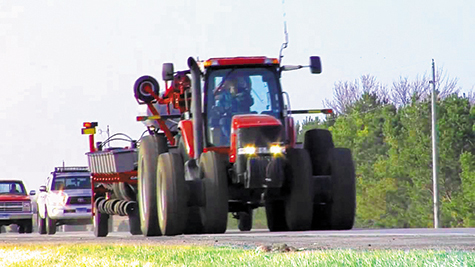
There is a certain peace and serenity that comes with living in the country. Personally, I would commute an hour’s drive of backroads before five minutes in a Winnipeg rush hour.
In this part of the world, many farmsteads have become idyllic rural homes. The roads that lead to them, and the fact that they exist, indicate the rich history of agriculture and our early settlers. For example, the grid roads provided access to fields and the homes of those who worked them. These roads also established the unit of measurement for land we still use today: one square mile is known as a Section, or 640 acres.
Many prairie communities like ours came into being because of agriculture. Back then, 90 percent of people had one degree of separation to the farm. Today, that number is below three percent. Aside from bridging the rural and urban gap in knowledge of how food is produced, another major concern is the safety surrounding the fields themselves.
As fall approaches, and with crops being weather- and time-sensitive, it’s about to become a very hectic time for farmers. One of the most concerning parts of our business is the safe movement of large equipment on public roads. In the next two months, odds are you’ll see a piece of harvest equipment moving daily.
Here are some tips to help safely navigate common situations you may encounter.
1. Blinking amber lights are a warning for slow-moving or over-width vehicles. Note that the lights are not always located at the extreme width of the implement. Exercise caution when passing.
2. All tractors are equipped with beacons and hazard lights. If it looks like the Vegas strip coming toward you, odds are there are multiple units approaching. The safest course of action is often to choose a different route, or at the very least slow down.
3. If you can’t see the mirrors of the operator, they can’t see you. Vehicles following too closely are not seen.
4. We do our best to stay on rural roads, but often we have to cross or move along the highway for short stretches. Most farm equipment moves at a top speed of 20 miles per hour and takes a much longer distance than a car to make a complete stop.
5. If you see a semi or tandem truck entering a highway, it could take up to a mile for them to get up to speed if they are loaded with grain. A little known fact is that if a truck operator can safely enter a roadway, allowing traffic to come to a controlled stop or safely slow down, they are within their legal rights according to the Highway Traffic Act.
6. If you approach large equipment on the backroads and you notice them stop, it means they have no more room to safely give. If the equipment is stopped and another vehicle comes into contact with it, the equipment operator is not at fault.
7. Grain carts may load up trucks on the backroads, a process which may take up to four minutes. They often cannot see behind them and will need to back up to get onto the field. One of the reasons this is done is to avoid dragging mud onto the roadways.
8. The white tanks moving around in the fall are filled with fertilizer. Due to their design and weight, they cannot be pulled at a speed greater than 40 kilometres per hour.
9. Passing too quickly on gravel is a sure way to crack a windshield or end up in a fishtail. Dirt roads are soft and often unmaintained, so often they are rutted, another common cause of front-end damage to a vehicle.
10. If you’re stopped at an intersection and see oncoming farm equipment, stay behind the stop line. Semis and farm equipment require a larger radius to turn.
In short, we’re heading into a two-month season during which a lot of food will be moving around the countryside. Be alert, prepare to slow down, and please share the road. The farmers in our communities are concerned for your safety as well as their own.
Let’s have a safe harvest, everyone!



















